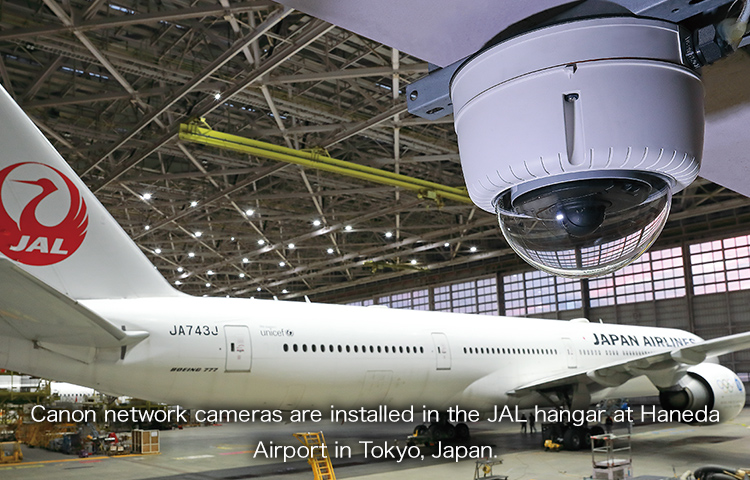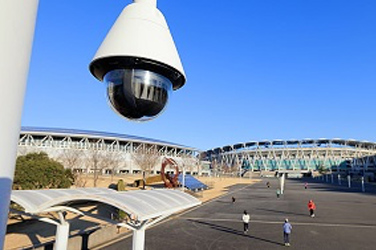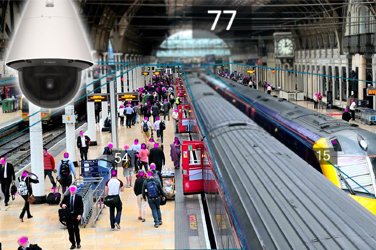

How Canon's network cameras help to achieve the goal of 100% on-time departures.
Keeping Aircraft Safe
In order to achieve 100% on-time departure rates, aircraft hangars require a network camera system capable of clear and sharp footage. It is in such locations, with a constant stream of aircraft, people, and vehicles, that Canon’s network camera systems prove their effectiveness.
July 11, 2019Activity introductions
Interviewing those in charge of ensuring aircraft safety
JAL Engineering Co., Ltd., which handles aircraft safety and quality control, has adopted Canon’s network camera system for its hangars.
Inside the hangars, in addition to aircraft receiving routine maintenance, there are also aircraft undergoing line maintenance during their turnaround time, as well as emergency maintenance conducted in the event of a malfunction. Accordingly, there is a constant stream of aircraft, people, and vehicles moving about. JAL Engineering previously used a surveillance system comprising 60 to 70 cameras, but due to increased security needs, the company decided to upgrade to a system with higher precision, and chose Canon’s network camera system.
Ko Misawa of the company’s Haneda Airport Maintenance Center, was also in charge of the implementation of the new system. He explains why his company chose Canon: “To establish a higher level of safety management, we placed top priority on a system that would produce clear, sharp images. However, due to wiring issues, we couldn’t install cameras in some places in the hangar. To cover every part of the very large hangar, we needed advanced camera functionality that allowed us to easily control the zoom, change the direction of the lens and also produce clear images at night.”
Canon’s network cameras combine lens and video technologies to produce high-quality, high-resolution images while maintaining a wide field of view. They are also equipped with functionality to enable optimal shooting during day and night and deliver high-quality images from the center of the shot to the periphery.
“What impressed us the most was the clarity of the images. Faces were recognizable even in images taken with the 20x optical zoom. We recognized Canon’s strengths as a camera manufacturer through such capabilities as the sharpness of images even when shot in total darkness and ultra-wide-angle cameras that enable the capture a wide areas even in small spaces,” Misawa comments.
Delivering optimal solutions by incorporating IT and site-relevant proposals
While implementing the new system, the engineers and persons in charge at Canon formed a “Canon team” that repeatedly met with JAL and performed on-site inspections.
Says Misawa: “JAL Engineering had objectives and key locations where we wanted to strengthen surveillance. We explained these to the Canon team, who then created a detailed plan that addressed these needs. There were some areas where camera installation was challenging, and others where wiring could not reach, but the engineers were able to continue brainstorming and proposing new solutions. Ultimately, this led to a “web of eyes” in the form of a 128-camera network. This is the product of our close collaboration and teamwork with Canon, and we are very proud of it.”
Further improvements were made in the high-capacity data management system, Misawa adds.
“Thanks to cutting-edge data compression technologies, it is now possible to store video for long periods of time. If a problem occurs, we can now go back in time and verify video in chronological order to thoroughly troubleshoot the issue.”
By utilizing an image compression method that achieves both high image quality and a high compression rate, Canon realized a surveillance system with less strain on the network even when transmitting high resolution files. The high compression rate reduces the required hard disk capacity and makes it possible to record video for longer durations, proving to be incredibly effective for high-capacity storage of footage from multiple cameras.
Overcoming on-site challenges to improve operations—the expanding possibilities of network cameras
“When the completed system began operating, we witnessed improvements on the hangar floor,” says Mr. Misawa.
Before, a late arrival of an aircraft, in spite of numerous exchanges made with the aircraft, resulted in lost time waiting at the hangar. After the system was introduced, it became possible to monitor the aircraft coming in or leaving in real-time via the system. Additionally, we are able to now visually check the progress of work using the cameras.”
The primary mission of maintenance crews is to precisely complete the work without any error in the limited time available.
“At JAL Engineering, we coined the term ‘Zero Zero 100’ to represent our goal of zero irregular operations, zero in-flight malfunctions and 100% on-time departures. I feel that the system renewal has allowed us to achieve improvements in both security and productivity.”
Canon’s network camera system watches over and helps improve business operations for the aircraft maintenance floor. Using the power of cutting-edge technologies, Canon will strive for the contribution to safety and security in a range of various fields.




